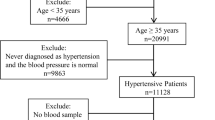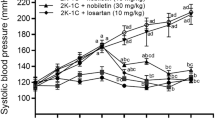Abstract
Hypertension associated with hyperhomocysteinemia (HHcy) is associated with a high risk of vascular diseases. However, the mechanisms of HHcy-associated hypertensive renal damage and the efficacy of folic acid (FA) as a treatment have not been fully elucidated. The aim of the present study was to evaluate whether lowering the plasma homocysteine (Hcy) level using different doses of FA can reduce HHcy-associated glomerular injury in spontaneously hypertensive rats (SHRs) and to clarify the potential mechanisms of such effects. SHRs were randomized into a control group, HHcy group, HHcy + low-dose FA (LFA) group, and HHcy + high-dose FA (HFA) group. Compared with the control group, the HHcy group had reduced serum superoxide dismutase and GFR levels and elevated serum malondialdehyde and urinary albumin creatinine ratio levels. Increased extracellular matrix of the glomerulus and an increased glomerular sclerosis index, podocyte foot process effacement and fusion, as well as increased podocyte apoptosis, were observed in the HHcy group compared with the control group; these effects were associated with increased expression of NOX2 and NOX4 and decreased nephrin expression in renal tissue from SHRs with HHcy. HHcy-induced changes were counteracted by LFA and HFA treatment. Apart from lower levels of NOX2 in the HHcy + HFA group, there were no significant differences in other indicators between the HHcy + LFA and HHcy + HFA groups. These results suggest that even at a low dose, FA can reduce plasma Hcy and attenuate HHcy-induced glomerular injury by inhibiting oxidative stress and apoptosis.
This is a preview of subscription content, access via your institution
Access options
Subscribe to this journal
Receive 12 print issues and online access
$259.00 per year
only $21.58 per issue
Buy this article
- Purchase on Springer Link
- Instant access to full article PDF
Prices may be subject to local taxes which are calculated during checkout





Similar content being viewed by others
References
Sacco RL, Adams R, Albers G, Alberts MJ, Benavente O, Furie K, et al. Guidelines for prevention of stroke in patients with ischemic stroke or transient ischemic attack: a statement for healthcare professionals from the American Heart Association/American Stroke Association Council on Stroke: co-sponsored by the Council on Cardiovascular Radiology and Intervention: the American Academy of Neurology affirms the value of this guideline. Stroke. 2006;37:577–617.
Huo Y, Li J, Qin X, Huang Y, Wang X, Gottesman RF, et al. Efficacy of folic acid therapy in primary prevention of stroke among adults with hypertension in China: the CSPPT randomized clinical trial. Jama. 2015;313:1325–35.
Graham IM, Daly LE, Refsum HM, Robinson K, Brattström LE, Ueland PM, et al. Plasma homocysteine as a risk factor for Vascular Disease. Jama. 1997;277:1775–81.
Jiang S, Li J, Zhang Y, Venners SA, Tang G, Wang Y, et al. Methylenetetrahydrofolate reductase C677T polymorphism, hypertension and risk of stroke: a prospective, nested case-control study. The. Int J Neurosci. 2017;127:253–60.
Towfighi A, Markovic D, Ovbiagele B. Pronounced association of elevated serum homocysteine with stroke in subgroups of individuals: a nationwide study. J Neurol Sci. 2010;298:153–7.
Yun L, Xu R, Li G, Yao Y, Li J, Cong D, et al. Homocysteine and the C677T gene polymorphism of its key metabolic enzyme MTHFR are risk factors of early renal damage in hypertension in a Chinese Han population. Medicine 2015;94:e2389.
Kuang ZM, Wang Y, Feng SJ, Jiang L, Cheng WL. Association between plasma homocysteine and microalbuminuria in untreated patients with essential hypertension: a case-control study. Kidney Blood Press Res. 2017;42:1303–11.
Chuong Nguyen MV, Lardy B, Paclet M-H, Rousset F, Berthier S, Baillet A, et al. Les NADPH oxydases, Nox. Médecine/Science. 2015;31:43–52.
Cifuentes-Pagano E, Csanyi G, Pagano PJ. NADPH oxidase inhibitors: a decade of discovery from Nox2ds to HTS. Cell Mol Life Sci. 2012;69:2315–25.
Gorin Y, Block K. Nox4 and diabetic nephropathy: with a friend like this, who needs enemies? Free radical biology &. Medicine 2013;61:130–42.
Gorin Y, Block K. Nox as a target for diabetic complications. Clin Sci 2013;125:361–82.
Shastry S, Ingram AJ, Scholey JW, James LR. Homocysteine induces mesangial cell apoptosis via activation of p38-mitogen-activated protein kinase. Kidney Int 2007;71:304–11.
Yi F, Zhang AY, Li N, Muh RW, Fillet M, Renert AF, et al. Inhibition of ceramide-redox signaling pathway blocks glomerular injury in hyperhomocysteinemic rats. Kidney Int 2006;70:88–96.
Ngarashi D, Fujikawa K, Ferdaus MZ, Zahid HM, Ohara H, Nabika T. Dual inhibition of NADPH oxidases and xanthine oxidase potently prevents salt-induced stroke in stroke-prone spontaneously hypertensive rats. Hypertens Res. 2019;42:981–9.
Tossidou I, Teng B, Drobot L, Meyer-Schwesinger C, Worthmann K, Haller H, et al. CIN85/RukL is a novel binding partner of nephrin and podocin and mediates slit diaphragm turnover in podocytes. J Biol Chem. 2010;285:25285–95.
Deen WM. What determines glomerular capillary permeability? J Clin Investig. 2004;114:1412–4.
Li M, Chen J, Li YS, Feng YB, Gu X, Shi CZ. Folic acid reduces adhesion molecules VCAM-1 expession in aortic of rats with hyperhomocysteinemia. Int J Cardiol. 2006;106:285–8.
Romecin P, Atucha NM, Navarro EG, Ortiz MC, Iyu D, Rosado JA, et al. Role of homocysteine and folic acid on the altered calcium homeostasis of platelets from rats with biliary cirrhosis. Platelets 2017;28:698–705.
Li Y, Qin X, Luo L, Wang B, Huo Y, Hou FF, et al. Folic acid therapy reduces the risk of mortality associated with heavy proteinuria among hypertensive patients. J Hypertens. 2017;35:1302–9.
Cagnacci A, Cannoletta M, Volpe A. High-dose short-term folate administration modifies ambulatory blood pressure in postmenopausal women. A placebo-controlled study. Eur J Clin Nutr. 2009;63:1266–8.
Qin X, Li J, Cui Y, Liu Z, Zhao Z, Ge J, et al. MTHFR C677T and MTR A2756G polymorphisms and the homocysteine lowering efficacy of different doses of folic acid in hypertensive Chinese adults. Nutr J. 2012;11:2.
Zappacosta B, Mastroiacovo P, Persichilli S, Pounis G, Ruggeri S, Minucci A, et al. Homocysteine lowering by folate-rich diet or pharmacological supplementations in subjects with moderate hyperhomocysteinemia. Nutrients 2013;5:1531–43.
Zhiqing W, Jing W, Haili X, Shaozhuang L, Chunxiao H, Haifeng H, et al. Renal function is ameliorated in a diabetic nephropathy rat model through a duodenal-jejunal bypass. Diabetes Res Clin Pract. 2014;103:26–34.
Raij L, Azar S, Keane W. Mesangial immune injury, hypertension, and progressive glomerular damage in Dahl rats. Kidney Int 1984;26:137–43.
Yu B, Xu D, Sun H, Yang K, Luo M. Comparative analysis of mechanical properties of PWV, NO and ascending aorta between WHY Rats and SHR Rats. Acta Cardiol Sin. 2015;31:6.
Li N, Chen Y-F, Zou A-P. Implications of hyperhomocysteinemia in glomerular sclerosis in hypertension. Hypertension 2002;39:443–8.
Xu X, Qin X, Li Y, Sun D, Wang J, Liang M, et al. Efficacy of folic acid therapy on the progression of chronic kidney disease: the renal substudy of the China stroke primary prevention trial. JAMA Intern Med. 2016;176:1443–50.
Tamadon MR, Jamshidi L, Soliemani A, Ghorbani R, Malek F, Malek M. Effect of different doses of folic acid on serum homocysteine level in patients on hemodialysis. Iran J Kidney Dis. 2011;5:93–96.
Faraci FM, Lentz SR. Hyperhomocysteinemia, oxidative stress, and cerebral vascular dysfunction. Stroke 2004;35:345–7.
Yi F, Zhang A, Janscha J, Li P, Zou A. Homocysteine activates NADH/NADPH oxidase through ceramide-stimulated Rac GTPase activity in rat mesangial cells. Kidney Int 2004;66:1977–87.
Shen GX. Oxidative stress and diabetic cardiovascular disorders: roles of mitochondria and NADPH oxidase. Can J Physiol Pharmacol. 2010;88:241–8.
Hwang SY, Siow YL, Au-Yeung KK, House J, O K, et al. Folic acid supplementation inhibits NADPH oxidase-mediated superoxide anion production in the kidney. Am J Physiol Ren Physiol. 2011;300:F189–98.
Wartiovaara J, Öfverstedt L-G, Khoshnoodi J, Zhang J, Mäkelä E, Sandin S, et al. Nephrin strands contribute to a porous slit diaphragm scaffold as revealed by electron tomography. J Clin Investig. 2004;114:1475–83.
Tryggvason K, Wartiovaara J. Molecular basis of glomerular permselectivity. Curr Opin Nephrol Hypertens. 2001;10:543–9.
Zhang C, Hu JJ, Xia M, Boini KM, Brimson CA, Laperle LA, et al. Protection of podocytes from hyperhomocysteinemia-induced injury by deletion of the gp91phox gene. Free Radic Biol Med. 2010;48:1109–17.
Wharram BL, Goyal M, Wiggins JE, Sanden SK, Hussain S, Filipiak WE, et al. Podocyte depletion causes glomerulosclerosis: diphtheria toxin-induced podocyte depletion in rats expressing human diphtheria toxin receptor transgene. J Am Soc Nephrol. 2005;16:2941–52.
Huber TB, Hartleben B, Kim J, Schmidts M, Schermer B, Keil A, et al. Nephrin and CD2AP associate with phosphoinositide 3-OH kinase and stimulate AKT-dependent signaling. Mol Cell Biol. 2003;23:4917–28.
Huber TB, Kottgen M, Schilling B, Walz G, Benzing T. Interaction with podocin facilitates nephrin signaling. J Biol Chem. 2001;276:41543–6.
Wang H, Song W, Hu T, Zhang N, Miao S, Zong S, et al. Fank1 interacts with Jab1 and regulates cell apoptosis via the AP-1 pathway. Cell Mol life Sci. 2011;68:2129–39.
Acknowledgements
This study was supported by the Shandong Provincial Key Research and Development Programme Foundation, China (Grant No. 2018GSF118009), the Technology Programme Foundation of Jinan, China (Grant No. 201821007), and the Shandong Provincial Medical Science and Technology Development Programme Foundation, China (Grant No. 2017WS462).
Author information
Authors and Affiliations
Contributions
NG and RX designed the experiment; NG, YZZ, LLi, PC, and LLin performed the experiments; LLei, and XZ analyzed the data and prepared the figures; NG, YZZ, and RX wrote the manuscript; and RX had primary responsibility for the final content. All authors read and approved the final manuscript.
Corresponding author
Ethics declarations
Conflict of interest
The authors declare that they have no conflict of interest.
Additional information
Publisher’s note Springer Nature remains neutral with regard to jurisdictional claims in published maps and institutional affiliations.
Supplementary information
Rights and permissions
About this article
Cite this article
Gao, N., Zhang, Y., Lei, L. et al. Low doses of folic acid can reduce hyperhomocysteinemia-induced glomerular injury in spontaneously hypertensive rats. Hypertens Res 43, 1182–1191 (2020). https://doi.org/10.1038/s41440-020-0471-8
Received:
Revised:
Accepted:
Published:
Issue Date:
DOI: https://doi.org/10.1038/s41440-020-0471-8



